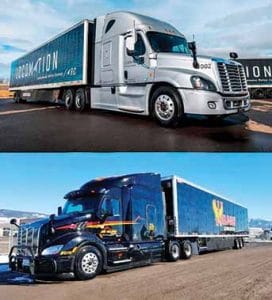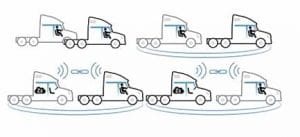Locomation has developed autonomous trucking technology to address trucking industry woes.
Story by Deepti Thore
With companies from diverse backgrounds engaged in the development of automation technologies in the field of commercial vehicles, it should not come as a surprise that Locomation, a Pittsburgh, PA (US)-based company has come out with yet another autonomous trucking technology suite to ease the pain points of the trucking industry. There is a surprise element however, and in the manner in which the company has leveraged Artificial Intelligence (AI) to develop its technology offering. Accounting for an increasing pace of the society, and the rising need of e-commerce, Locomation has focused on driver augmentation through Autonomous Relay Convoying (ARC) system. Elevating the driver to the position of a smart manager, ARC empowers him or her to manage two trucks by acting as a force multiplier.
Supporting a business equation laced with radically improved cost efficiencies and economic yields, ARC is about autonomously monitored operations that are safe and secure. Claiming to reduce up to 50 per cent labour costs, up to 30 per cent operating expenses and up to eight-per cent fuel costs, the ARC builds around the driver rather than to omit him. It does so with an objective to deliver full vehicle automation that incorporates human interaction. This, it does with an ambition to eliminate all truck-involved accidents. Designed and developed to offer a superior driving experience to professional truck drivers, the ARC has also been designed and developed with a distinct shift of drivers in view. Pointing at a report by American Trucking Associations, which state that the respective industry is short of 50,000 drivers, the ARC is designed to deal with the challenge of truck drivers among other pain points.
Easing the pain points
With more and more drivers retiring or quitting, the US truck industry is facing its own set of challenges. Expecting the driver shortfall to rise to the tune of 1,74,000 drivers by 2026 according to a report, the US trucking industry, with the use of the ARC, could actually define, attack and address its pain points. Mentioned Tekin Mericli, CTO, Locomation, that autonomous driving technology can drastically help resolve the challenge of driver shortage by offering driver safety, improved efficiency and lowering the costs. “Some companies are already seeing 100 per cent annual driver turnover rates,” he informed. Having five autonomy experts from Carnegie Mellon’s National Robotics Engineering Center onboard, Locomotion, since 2018, has been working on autonomous vehicles and AI-driven systems with detailed insight into diverse application situations concerning commercial and defence vehicles.
The company, for shaping the future of transportation, is focusing on comfort as well. It is anticipating that the kind of technology that they have developed will come pre-installed in trucks in the future. Keen to offer the ARC as a retrofit kit that could be installed on existing trucks or existing fleets, Locomotion is working on a platform that is highly scalable and reliable.
The ARC system
Equipped with an intricate system of cameras, lidar (light detection and ranging) and radar sensors to see the surroundings, these ARC system works such that two trucks leave the dock with a load with one driver each. They pass through the urban obstacles to reach the highway. Once they reach the highway, they connect and form a convoy. One truck assumes the lead role and guides the trailing autonomous truck down the highway. The leading truck also helps the trailing truck to stay between the lines, navigate lane changes and avoid other cars. With the lead driver augmented by Locomation’s technology platform, the following truck engages full autonomy with a push of button. In doing so, it enables the driver to clock out and rest. At this time, the follower truck is fully driverless (SAE Level 4). Swapping itself periodically with the following truck to alternate driver resting periods making life easier for professional truckers, the lead truck sets a high level of connectivity in the process and not just the machine that follows it.
For ‘vehicle-to-vehicle communication’, the trucks use antennas equipped to share data about speed, acceleration, steering wheel angle, and the amount of throttle and brake being applied. No human intervention is involved in case the technology makes any mistake. Drivers can simply move to the back of the vehicle to stretch out in the sleeper berth and the technology does the rest. A shadow autonomy stack in the lead truck generates driving actions without actually putting them into action. These actions are recorded and can be compared to the driver’s actions to produce valuable data for testing higher levels of autonomy. To revolutionise the road transport industry, Locomation has designed and developed the ARC system such that it could be scaled up into a highly effective autonomous trucking platform.
Revolutionising the trucking industry
Partnering its research with the Transportation Research Center Inc.(TRC) to test the autonomous truck platform at their test facility in Ohio, US, Locomation is fine-tuning its technology offering to make it even better. It is looking at its active testing research project as the one that will help it to drive autonomous truck development to greater heights. Having taken to shared engineering and safety validation programs, the company, according to Dr Çetin Meriçli, CEO, Locomation, is emphasising on the development, improvement and perfection of its autonomous systems by partnering its research with TRC. “The TRC is a top destination to rigorously test and validate our technology,” he mentioned. Expected to add to the knowledge of the team at Locomation, the testing regime at TRC involves rigorous analyses and validations.
By taking its self-driving trucks off the test track, Locomation has also partnered with Wilson Logistics to move cargo on the nation’s highways for more than 400 miles between Oregon and Idaho in the US. It has, on the highway, used the convoy system to its advantage. Competing with a number of companies — from startups, massive technology corporations to big trucking fleets — working on automation in the transport space, Locomation is confident of further refining its technology platforms and of developing new solutions. Currently, its convoy system may deploy two trucks together, but that is not stopping it from working on ways to increase this number. By doing so, Locomation is confident that the concept of truck platooning with take-off and its real-world benefits will be there for all to see.






























